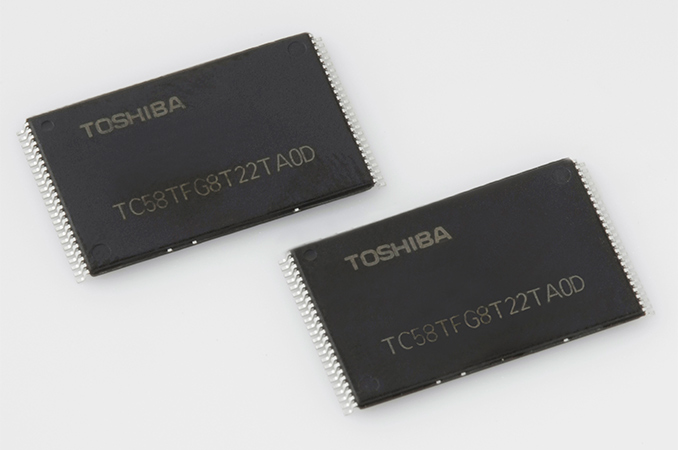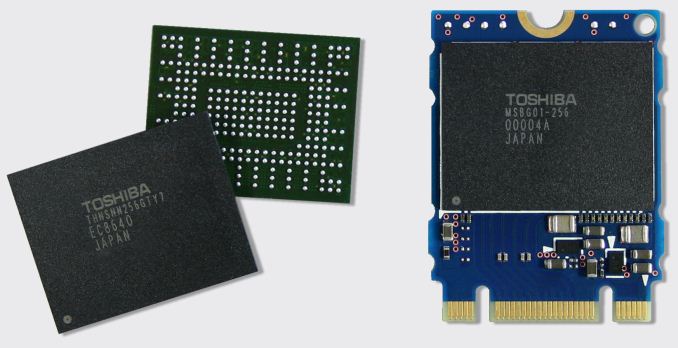Toshiba Samples 64-Layer 512 Gb BiCS 3D NAND, Announces 1 TB BGA SSD
by Anton Shilov on February 23, 2017 11:00 AM EST
Toshiba on Wednesday said that it had begun to sample its latest BiCS 3D NAND flash memory chips with 64 word layers and 512 Gb capacity. A co-development project with Western Digital, the two companies intend to produce the new ICs (integrated circuits) in high volume sometimes in the second half of this year. Among the first products to use the new chips will be Toshiba’s BGA SSD with 1 TB capacity.
Looking at the specifications, Toshiba's 512 Gb (64 GB) 64-layer BiCS 3D NAND will be TLC-based, with the use of TLC being unsurprising here as all makers of non-volatile memory nowadays concentrate on TLC ICs for SSDs. Toshiba as well as its fab and development partner (Western Digital) has not formally revealed the interface speed of their new 512 Gb 3D NAND ICs nor the number of planes per IC, but these are details that the companies are probably going to share when they are ready to ship such devices in high volume (or simply decide to publish their ISSCC presentation from earlier this month).
In fact, a 64-layer 3D TLC BiCS NAND chips per se are not a 2017 breakthrough. Western Digital, has been using its 64-layer 3D TLC NAND devices for actual products (e.g., removable media) since November or December. However, those 64-layer 3D TLC NAND ICs have capacity of 256 Gb, whereas the new chips can store 512 Gb of data. Toshiba itself says that its 256 Gb 64-layer BiCS ICs are in high-volume production today.
Toshiba and Western Digital said that high-volume manufacturing of their 512 Gb 64-layer devices will commence in the second half of 2017 in Yokkaichi, Japan. The two companies said that the new ICs will help them to address various retail, mobile and data center applications. The latter indicates that the devices will be used not only for removable media and mobile storage, but also for high-end enterprise-class SSDs.
Meanwhile, Toshiba’s BGA SSDs will be among the first to use the company’s new memory devices. The company plans to produce a BGA drive (as well as M.2 modules based on such BGA devices) with 1 TB capacity featuring 16 chips. Such SSDs are designed for various mobile and UCFF (ultra-compact form-factor) PCs and enable to reduce their thickness and overall footprint as well as improve battery life. Samples of the BGA drives will be available in April, whereas mass production will start sometimes in 2H 2017.
Note: Images are for illustrative purposes only.
Related Reading:
Source: Toshiba











8 Comments
View All Comments
BrokenCrayons - Thursday, February 23, 2017 - link
Does 3D TLC BiCS require occasional rewrites to preserve the state of each memory cell? I know planar TLC was supposed to have that sort of issue and it adversely impacted long-term data storage if it was in an infrequently used device. In fact, does any 3D TLC have that problem these days?hojnikb - Thursday, February 23, 2017 - link
Every flash device needs this, but some need a lot longer to degrade.saratoga4 - Thursday, February 23, 2017 - link
It's temperature dependent. Put any nand in your freezer and it's good for decades or centuries. Put it in a 70C chassis and electrons leak a lot faster and may need refreshes during its service life.Ej24 - Friday, February 24, 2017 - link
It a little more complex than that. I've seen a couple breakdowns of read/write wear and data retention rates at various temperatures from -20C to 70C. Can't find the link now but, ideally you should write 'hot' and store 'cold' for maximum data retention, but temperatures too low have been shown to corrupt NAND as well soo probably more like store cool, like refrigerator temps.evancox10 - Thursday, February 23, 2017 - link
With 3D flash, they raised the bit cell size back up, so reliability should be better. Smaller cells are more susceptible to that (and other) issuesGlaring_Mistake - Thursday, February 23, 2017 - link
Like hojnikb says voltage drift will happen to any NAND given time (depending on a number of factors).It is just that TLC NAND (especially at small lithographies) suffers more noticeably from this since it doesn’t have the margins that MLC NAND or SLC NAND do (everything else being equal).
That SSDs using 3D TLC NAND may need to do some rewrites in order to keep everyting in shipshape is something I have seen personally (though under a bit more challenging conditions than normal perhaps).
The 3D TLC NAND Intel/Micron makes would likely be one of the more easily affected since it looks like they may have gone with a 20nm lithography rather than something like 40nm like Samsung did (don’t know what lithographies Toshiba/WD or SK Hynix have gone with though).
Regarding the 3D TLC NAND from Toshiba/WD I think it shouldn’t need to rewrite files much except for in challenging conditions (or if the data has been on the drive a fairly long time).
Unless of course there is either something very wrong with its construction or it is paired with an inept controller and/or using poorly written algorithms.
BrokenCrayons - Friday, February 24, 2017 - link
Thanks all for the thoughts on the matter. I've been pretty reluctant to buy TLC-based drives because of the data loss/rewrite situation because I tend to use one computer or another and then abandon it for weeks or sometimes months -- usually seasonally since I run larger hotter systems in the winter and then switch to cooler systems in the summer. It means I'll put aside one laptop or another for a good 5-6 months and the need for TLC to have occasional rewrites seemed like it might have meant blowing the dust off a computer I'd otherwise forget about for a long time. It sounds like its an unfounded worry.Samus - Friday, February 24, 2017 - link
Don't leave your laptop in the sun for weeks at a time without powering it on.